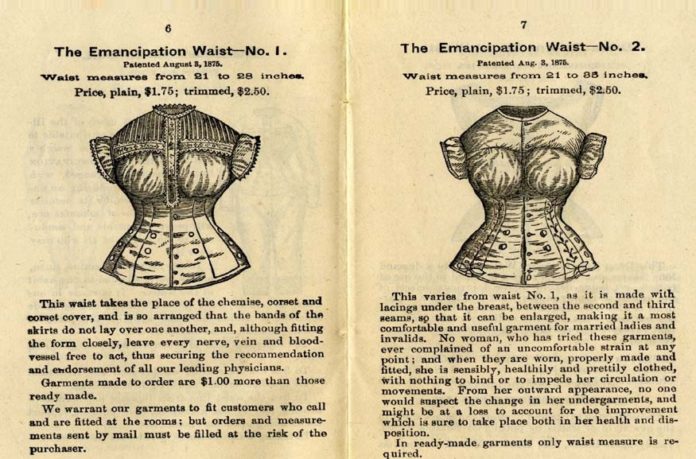Disclaimer: The Eqbal Ahmad Centre for Public Education (EACPE) encourages critical and independent thinking and believes in a free expression of one’s opinion. However, the views expressed in contributed articles are solely those of their respective authors and do not necessarily reflect the position or policy of the EACPE.
Down the centuries, most cultures have had their own popular norms for fashion in women’s clothing, footwear and hairstyling, going as far as body parts alteration. Ostensibly, these fashions enhanced desirability and sexual-appeal for women. As a matter of fact popular concepts of female beauty evolved out of sub-conscious conditioning of the mind by a society which used them for control and manipulation of behaviour, as well as social strata identification. They were deeply ingrained in the minds of women, who strived to conform to these norms of desirability even at the cost of great discomfort, damage to health and restriction of movement. Paradoxically, they internalised these social dictates to the extent of believing them to be their own choices and remained devoted to self-damaging traditions.
Let’s start with the fashion of tight-laced corsets in the western societies of the nineteenth century. Remember the scene from the movie ”Gone with the Wind” where Scarlett holds on to a bed post as her nanny puts her might into cinching her waist into a tight corset? It illustrates the prevalent effort to achieve the ideal ”wasp-waist” of 19-20”, at the cost of numerous health problems like difficult breathing, fractured ribs, distortion of spine, stunted growth and damage to internal organs.
Another nineteenth century fashion which brought death by fire to many were crinoline dresses with huge, hooped skirts made up of large amounts of inflammable fabric. These over sized dresses also caused accidents by getting caught in wheels of carriages and blowing away women with gusts of wind.
In China, a small three-inch foot known as a golden lotus represented refinement and desirability in brides, no different from the tiny waist of Victorian England. Foot- binding involved breaking and binding all but the big toes and binding them flat against the sole with a ten feet long silk strip to turn them into a claw-like extremity. This cruel tradition often caused infections, severe pain and a slow, awkward hobbling gait.
Among the Kayan women of Burma, the hallmark of beauty demanded an excessively long neck achieved by wearing neck rings from a very young age. This was extremely painful and resulted in permanent deformity and spinal damage. In many societies women go through painful procedures like multiple piercing of ears and noses in order to support heavy and bothersome ornaments.
Many a modern woman tortures herself to undergo risky cosmetic surgical procedures in an effort to appear more attractive. She bears the discomfort of walking in high heels and injuring her leg muscles, and will go to extreme measures to attain a slimmer figure.
The modern woman will be truly free only when she shakes herself out of these given insecurities and mental traps and strives for achievement and ability-enhancements.
The diversity between various indices of fashion prevalent at different places and times proves that most concepts of ideal beauty in women come from social conditioning and an underlying control mechanism that sets strict adherence to given codes of dress and behaviour for women. It is a disturbing fact that most aspects of women’s beauty are tied up with restricted movement, pain and discomfort, eventually translating into restriction of free movement and self management. Elaborate and impractical clothing and ornaments result in the women being confined to the home as ornamental and dependant entities rather than being self sufficient through being physically active and acquiring practical skills for survival. The underlying message is also that discomfort and pain is a normal exchange for conformity and obedience by young women, and must be accepted as such.
Elaborately adorned wives of rich men were a public statement of his high station. The higher the social station of women, the more elaborate and restrictive would be their fashions. Hobbling around in massive skirts, bound feet and high heels would show that one was rich enough to employ others for everyday menial tasks.
Perpetrated benchmarks for desirability also cause the average woman to develop a sense of inadequacy almost amounting to guilt for not measuring up to the optimum standards of what one should be. She is a lesser daughter, a lesser wife for a myriad given reasons: a dusky complexion, a short stature, a flat nose, a thick waist, a hairy torso, the wrong colour of eyes. How can she doubt it when this has been hammered into her head and enforced by her own mother who has earlier imbibed and internalized this regimen from her family? Therein begins a series of obsessive attempts to “make up” for these “failings” and fill up a huge resultant vacuum in her self-esteem and self image.
The modern woman will be truly free only when she shakes herself out of these given insecurities and mental traps and strives for achievement and ability-enhancements. Let her accept her body image for what it is and seek no approval ratings for any physical attributes aside from what naturally applies to both sexes and concerns overall healthy and pleasing personalities.
About the Author:

Dr Ranjit Powar is a psychologist who has served with the Punjab Civil Services and earlier as a lecturer with the Punjabi University, Patiala. Besides writing as a freelancer, she works with NGOs for imparting employability training to high school students.








